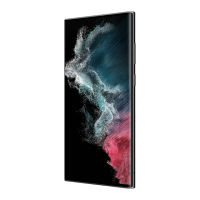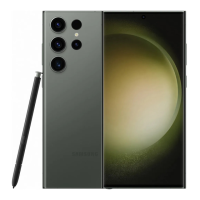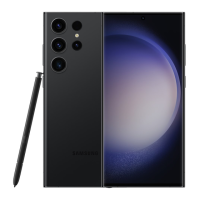Do you have a question about the Samsung SM-S901E/DS and is the answer not in the manual?
Details the physical components and layout of the Galaxy S22 Ultra.
Provides important safety and usage guidelines for the device's components.
Explains the function of physical buttons like Side and Volume buttons.
Describes the on-screen navigation buttons: Recents, Home, and Back.
Instructions on how to charge the device using a USB cable and adapter.
Information on using the device's built-in wireless charging coil.
Details how to use super fast or fast chargers for quicker battery charging.
Explains how to charge other devices using the phone's battery.
Offers tips and settings to conserve the device's battery power.
Provides essential advice and warnings for safe and effective battery charging.
Explains how to insert and use nano-SIM cards and eSIMs.
Step-by-step guide for inserting SIM cards into the tray for Galaxy S22 Ultra.
Detailed instructions for inserting SIM cards into the tray for various models.
Guide on activating an eSIM using a QR code or through settings.
Explains how to manage SIM cards and eSIM settings in dual SIM devices.
Instructions on how to power the device on and off using the side button.
Steps to force restart the device if it becomes unresponsive.
Guidance for setting up the device for the first time after power on or reset.
Explains how to sign in, find ID, reset password, and sign out of a Samsung account.
Steps to recover or reset a forgotten Samsung account ID or password.
Instructions on how to sign out of the Samsung account and its implications.
Details basic touch gestures like tapping, dragging, swiping, and pinching.
Explains the functions of Recents, Home, and Back buttons on the navigation bar.
Instructions on how to hide the navigation bar for a wider screen view.
Describes the function and layout of the Home and Apps screens.
Explains how to navigate between the Home and Apps screens using gestures or buttons.
Guide on customizing the Home screen with wallpapers, widgets, and panels.
How to configure the device to show all apps directly on the Home screen.
Details the keyboard layout and how to input text, symbols, and uppercase letters.
Guide on switching input languages and selecting different keyboard types.
Instructions on how to select, copy, cut, and paste text on the device.
Steps for downloading apps from Galaxy Store/Play Store and managing them.
How to uninstall, disable, or enable applications on the device.
How to grant or deny permissions for apps to access device features and data.
Guide on making voice and video calls using the Phone app and keypad.
How to set up and use speed dial numbers for quick calling.
Steps for making calls to international numbers.
How to block unwanted callers and unknown numbers.
Instructions for creating new contacts, importing from storage, and syncing with web accounts.
How to find contacts and initiate calls or messages from the contacts list.
Steps for deleting, sharing contacts, creating groups, and merging duplicates.
How to send text messages, voice messages, and attach files.
Guide on viewing conversations, replying to messages, and adjusting font size.
Options for sorting, deleting messages, and customizing message settings.
Explains how to run multiple apps simultaneously in split-screen or pop-up view.
How to activate split-screen or pop-up view using screen swipes.
Using the Recents button to open apps in split-screen or pop-up view.
Adjusting window size, moving pop-up windows, and saving split-screen layouts.
Overview of Bixby, its capabilities, and how to access it.
How to interact with Bixby using voice commands and wake-up phrases.
Instructions on how to use Bixby by typing text instead of speaking.
Explains Bixby Vision for image recognition and information search.
Methods to launch Bixby Vision and its features like Translate and Discover.
How to search for information, bookmark pages, and navigate the web.
Guide on activating and using Secret mode for private browsing.
How to set up Samsung Kids, restrict access, and use parental controls.
Steps to exit Samsung Kids mode securely using the unlock code.
Overview of Samsung Health for tracking wellness, fitness, and health tips.
Guide on navigating the app and using its features like home cards and monitoring.
Explains Samsung Members for support, community, news, and tips.
Information about the Samsung Global Goals initiative.
Details on accessing free video content via Samsung TV Plus.
Information on accessing products and services via the Galaxy Shop app.
How to manage wearable devices like Galaxy Buds by connecting to the phone.
Guide on managing schedules, creating events, and syncing calendar with accounts.
How to register to-do items as reminders and manage them.
How to access and manage files stored on the device.
Features for setting alarms, checking time, and using timers.
Using the calculator for basic arithmetic and scientific calculations.
How to access and manage downloaded games in one place.
Options to adjust game performance: Performance, Standard, Battery saver.
How to use Game Booster for an optimized gaming environment and its features.
How to open apps in pop-up windows while playing games.
Control and manage smart appliances and IoT products via SmartThings.
View phone content on a large screen like a TV or monitor via screen mirroring.
Share Bluetooth speaker audio with another person or listen together with Galaxy Buds.
How to connect the phone to a Windows computer for data access.
Using the Phone Link app to access photos, messages, apps, and notifications.
Use phone as a computer by connecting to an external display with keyboard/mouse.
Steps to connect the phone to a TV or monitor using an HDMI adapter.
How to connect the phone to a TV wirelessly for Samsung DeX.
Using an external keyboard/mouse and phone as a touchpad for DeX control.
Lists and describes various Google apps like Chrome, Gmail, Maps, YouTube, etc.
Overview of S Pen features and basic usage precautions.
How to remove the S Pen from its slot and charge it for use.
Control apps remotely using S Pen gestures and button actions.
Use the S Pen button to take photos, burst shots, and switch cameras.
Change S Pen assigned actions, reset connection, and access Air command panel.
Details Air command features like Create note, Smart select, Screen write, Bixby Vision, Translate, etc.
How to manage the Air command icon on the screen.
Use S Pen to select areas for sharing, saving, or creating GIF animations.
Select and capture a portion of a video as a GIF animation using Smart Select.
Capture screenshots to write, draw, crop, or share them.
Create and send unique animated messages by recording handwriting or drawings.
Use Bixby Vision to search for relevant info or extract text from images.
Hover S Pen over text to translate it and convert units.
Reduce apps to thumbnails and open them in full screen by hovering S Pen.
Fill plans by writing or drawing directly on the calendar screen.
Convert handwriting input to text using the S Pen.
Preview content or info in a pop-up window by hovering S Pen.
Select multiple items or text quickly with S Pen for copy/sharing.
Quickly create memos by writing on the screen without turning it on.
Pin screen off memos to the Always On Display for quick access.
Use the S Pen button to unlock the device screen when it's locked.
Guide on creating new notes, inserting files, and deleting existing notes.
Write or draw in notes using handwriting features and tools.
How to erase handwriting using stroke or area eraser options.
Edit handwritten input by cutting, moving, resizing, or converting to text.
Features for straightening content, changing styles, using easy writing pad, and fixing shapes.
Record voice to notes, pin notes to Home, and clip content.
Social network for sharing S Pen artwork, viewing others' art, and getting tips.
Basic camera functions, modes, and etiquette for taking pictures.
Guide on opening the camera, focusing, and adjusting brightness for photos.
How to take photos, use zoom, focus, switch cameras, and use camera settings.
Explains various shooting options like flash, timer, aspect ratio, resolution, filters, and metering.
Using Photo mode, changing picture resolution, and utilizing shot suggestions for composition.
Tips for taking selfies, clear close-ups, and applying filters/beauty effects.
Guide on recording videos, changing resolution, and using Super steady stabilization.
How to use auto framing to automatically adjust shooting angle and zoom.
Record videos with multiple camera angles simultaneously (split or PIP view).
Adjust size/location of PIP window during recording or playback.
Record subject and filmer simultaneously on one screen (Galaxy S21 FE 5G).
Capture various pictures and videos in one shot, with automatic selection of best shots.
Capture photos/videos with blurred backgrounds and clear subjects, applying effects.
Manually adjust shooting options like exposure value and ISO for advanced control.
Details on ISO, Speed, EV, Focus, WB, MIC, and ZOOM settings in Pro modes.
Separate focus and exposure areas on the screen for precise adjustments.
Use Night mode for low-light shots and Food mode for vibrant food colors.
Capture wide scenes with Panorama mode and slow down fast moments with Super Slow-mo.
Automatically capture moments in super slow motion when motion is detected.
Record videos and specify sections to be played in slow motion.
Record scenes as fast-motion videos using Hyperlapse mode.
Adjust intelligent features, picture saving options, and video settings.
Select picture formats (HEIF, JPEG, RAW) and video options (Auto FPS, HDR10+).
Use Zoom-in mic, Auto HDR, Tracking auto-focus, Grid lines, Location tags, and Shooting methods.
Keep last settings, enable vibration feedback, and manage privacy options for the camera.
Access and manage images and videos stored on the device.
How to search, view, and sync images and videos.
View images, modify them, add to favorites, delete, share, and crop enlarged images.
Play videos, configure caption settings, adjust brightness, and enhance video quality.
Create albums, stories, sync media with cloud, delete items, and use recycle bin.
Provides AR features for capturing fun pictures or videos.
Create custom emojis by picking pre-made ones or making your own.
Create AR emojis, select them, delete them, and use them for videos or wallpapers.
Use AR emojis as profile pictures for Samsung account and contacts.
Create pictures/videos with emojis using Scene, Mask, Mirror, Play modes.
Create custom emoji stickers from expressions and actions for messages or social networks.
Use emoji stickers in messages or social networks via the Samsung Keyboard.
Record fun videos with virtual handwriting or drawings on faces or spaces.
Record and play voice recordings, bookmark them, and save files.
Select recording modes: Standard, Interview, and Speech-to-text.
Review interview recordings, mute/unmute specific sound sources.
Use Wallet for payments, identity verification, tickets, and digital car keys.
Register cards to Samsung Pay for online and offline payments.
Use biometric data with Samsung Pass for identity verification.
Add boarding passes/tickets, use phone as a digital car key.
Use NFC or UWB for unlocking/starting vehicles with digital key.
Initial setup for Samsung Pay, including account sign-in and PIN registration.
Steps to register credit or debit cards for making payments.
How to make payments using Samsung Pay and cancel transactions.
Share content with nearby devices using Wi-Fi Direct, Bluetooth, or QR codes.
Share content directly with people in your contacts list.
Encrypt and share content securely, preventing saving or forwarding.
Control who can find your phone for sharing: No one, Contacts only, Anyone nearby.
Capture screenshots using button combinations or palm swipe gestures.
Use toolbar for scrolling capture, writing/drawing, adding tags, and sharing.
Record the device screen, add drawing, S Pen pointer, or video overlay.
Connect devices via USB cable to transfer data from old device to new phone.
Transfer data wirelessly between devices using Wi-Fi Direct.
Back up data to a computer and import it to the new phone using Smart Switch.
Configure Wi-Fi, Bluetooth, NFC, UWB, Flight mode, SIM manager, and mobile networks.
Manage data usage, enable mobile hotspot/tethering, and customize connection settings.
Turn on Wi-Fi and connect to available networks, including auto-reconnect settings.
Check Wi-Fi quality and share passwords with other devices.
Connect devices directly using Wi-Fi Direct without an access point.
Safety warnings and compatibility notes for using Bluetooth.
Steps to pair your phone with other Bluetooth-enabled devices.
Share data like contacts or media files via Bluetooth.
Use NFC for product info, payments, and tickets. Read NFC tags.
Register for mobile payment services and set default payment apps for NFC.
Reduce data usage by limiting background app data and selecting apps for unrestricted data.
Set apps to use only Wi-Fi, mobile data, or both.
Share phone's mobile data connection with other devices via Mobile Hotspot.
Customize nearby device scanning, VPN, Private DNS, Ethernet, and system configuration.
Configure printer plug-ins, add printers, and print content from the device.
Settings for Quick Share, Music Share, Auto switch Buds, Call & text on other devices, Link to Windows, Multi control, Samsung DeX, Smart View.
Set modes based on activity/location or create routines for usage patterns.
Add custom modes and run them manually or automatically based on conditions.
Add custom routines, set manual/auto running conditions, and stop running routines.
Change sound mode (sound, vibrate, mute), vibration while ringing, temporary mute, ringtone, and notification sound.
Enhance audio with Dolby Atmos, Equaliser, UHQ Upscaler, and Adapt Sound features.
Play media sound from specific apps on connected Bluetooth devices separately.
Customize app notifications, sorting, lock screen display, pop-up style, and Do Not Disturb.
Adjust light/dark mode, brightness, motion smoothness, eye comfort, screen mode, font, zoom, resolution, full screen, camera cutout, timeout.
Adjust screen refresh rate (Adaptive, High, Standard) for smoother scrolling or battery saving.
Select screen modes (Vivid, Natural) to optimize display colors and adjust color tone.
Check battery status, enable power saving, set background limits, protect battery, and view info.
Change Home screen wallpaper and apply device themes for visual customization.
Configure Home screen layout and options.
Customize screen lock type, Extend Unlock, secure lock settings, lock screen items, widgets, and Always On Display.
Set device to unlock automatically based on trusted locations or devices.
Display clock, notifications, or music controls when the screen is off.
Steps to disable the Always On Display feature via notification panel or settings.
Check security status, manage accounts, device protection, app security, updates, biometrics, and permissions.
Set up face recognition for screen unlock and understand its precautions.
Tips for better face recognition, such as good lighting and clean camera lens.
Register face data, unlock screen with face, and delete registered face data.
How fingerprint recognition works, its security benefits, and precautions.
Conditions affecting fingerprint recognition performance and how to improve it.
Register fingerprints, unlock screen with fingerprint, and manage registered prints.
Set to show or hide the fingerprint icon on the screen when it is off.
Remove registered fingerprints from the device.
Protect private content and apps in a separate, secured storage area.
Steps to set up Secure Folder, including lock type and customisation.
Set auto lock conditions and move content like pictures/videos to Secure Folder.
Move content from Secure Folder, add apps, and add accounts for syncing.
Hide Secure Folder shortcut and uninstall the app with its content.
Secures Wi-Fi connection by encrypting data and disabling tracking apps.
Select apps to protect using Secure Wi-Fi for data safety.
Purchase paid plans for unlimited bandwidth protection or transfer plans.
Register biometric data to Samsung Pass for identity verification.
Use Samsung Pass for website and app sign-ins with autofill and passkeys.
Manage sign-in info, use Samsung Pass with apps, and auto-fill personal information.
Delete biometric data, sign-in info, and app data registered to Samsung Pass.
Manage location information permissions for apps and services.
Set up medical info, emergency contacts, and Emergency SOS.
Configure emergency sharing, driving notifications, ELS, alerts, and tracker notifications.
Sync accounts, back up data via Samsung Cloud, Google Drive, or Smart Switch.
Back up device data to Samsung Cloud and restore it later.
Configure settings for features provided by Google.
Enable and configure advanced features like Labs, S Pen, Side button, Multi window, Motions, One-handed mode, Bixby, Smart suggestions, Screenshots, Video call effects.
Turn on Gaming Hub and enhance video image quality.
Configure features like Lift to wake, double tap, alert on pickup, mute gestures, and palm swipe capture.
Change background, block noise, auto framing, and mic modes during video calls.
Install and use a second instance of messenger apps for separate accounts.
Steps to uninstall the second app instance and its related data.
Monitor device usage, set screen time goals, app timers, and manage parental controls.
Overview device status (battery, storage, security) and optimize performance.
Check and manage device battery, storage space, and memory usage.
Scan device for malware and check its security status.
Adjust performance profile, processing speed, and auto optimization.
Update software, run diagnostics, and use maintenance mode.
Check app usage, change settings, uninstall, or disable apps.
Customize languages, text-to-speech, voice input, date/time, keyboard, mouse, passwords, reset, and contact options.
Add new languages for system and app usage.
Configure various settings to improve device accessibility.
Check for and install software updates manually or automatically over Wi-Fi.
Information on security updates to protect device and personal information.
Access device name, status, legal info, software version, and battery status.
Important precautions for safe and proper use of the device and its features.
Adjust touchscreen contrast/brightness, view FCC ID, UWB restrictions, and regulatory info.
Warnings about magnets and explanations of instructional icons (Warning, Caution, Notice).
Information on supplied items, accessories, compatibility, and warranty.
Guidelines to maintain the device's IP68 water and dust resistance.
What to do when the device heats up while charging, including precautions.
Reasons for device heating during use and temporary solutions.
Actions to take if the device overheats, including performance limits and shutdown.
The device's recommended operating temperature range for optimal performance.
Warnings about extreme temperatures, direct sunlight, and unsuitable storage locations.
Overview of accessibility features for users with vision, hearing, or dexterity impairments.
Change display mode and apply high contrast theme, font, and keyboard for better visibility.
Adjust button shapes, reverse colors, adjust color tone, apply color filters, and reduce motion effects.
Reduce transparency/blur, dim screen, and use magnification gestures for screen viewing.
Use magnifier via camera, change cursor thickness/color, font, screen zoom, and speak keyboard input aloud.
Play audio descriptions for videos and use Bixby Vision for accessibility features.
Add voice recordings to NFC labels to identify objects by voice playback.
Activate/deactivate TalkBack, control screen with gestures, use reading menu, and manage image labels.
Customize TalkBack features like text-to-speech, verbosity, focus indicator, gestures, and keyboard input.
Transcribe speech to text and generate captions for media content.
Configure caption preferences and enhance sound quality for hearing aids.
Detect sounds for alerts, amplify ambient sound for better hearing, and adapt sound settings.
Turn off all sounds, use mono audio, and adjust left/right sound balance.
Control touchscreen using external switches or head/face gestures.
Display assistive shortcut icon for easy access to menus and configure contextual menus for apps.
Control device by voice using Voice Access and change call answering/ending methods.
Restrict device reactions to inputs and set touch and hold delay recognition time.
Adjust tap duration, ignore repeated touches, auto action after pointer stops, sticky/slow keys for external keyboards.
Set shortcuts to quickly open accessibility features using buttons or icons.
Set light notifications for alarms/calls and adjust time for pop-up windows.
View installed accessibility services on the device.
Explains prompts for Password, PIN, PUK, and PIN2 codes.
Solutions for weak signal reception and accessing options without subscription.
Troubleshooting steps when the device does not power on, likely due to battery.
Solutions for slow touchscreen response, device freezing, and fatal errors.
Steps for restarting, forcing a restart, and performing a factory data reset.
Resolve issues with call connection, microphone audio, echoes, network/internet connectivity, and battery charging.
Address faster battery depletion, camera launch errors, poor picture quality, and multimedia file errors.
Resolve Bluetooth connectivity issues, computer connection problems, and GPS location detection.
Address data loss, small gaps in device case, storage space, and Home button disappearance.
Safety warnings and instructions regarding battery removal by authorized service centers.
| Brand | Samsung |
|---|---|
| Model | SM-S901E/DS |
| Category | Cell Phone |
| Language | English |











